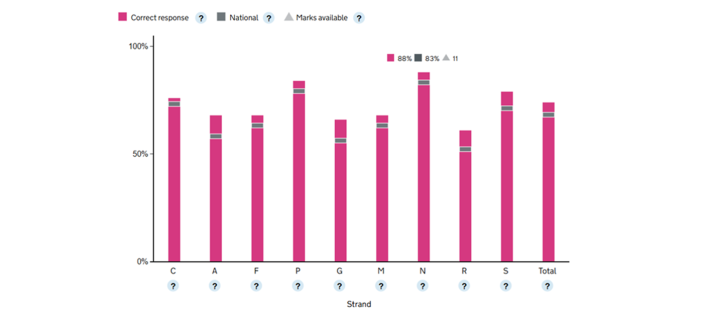(Updated for 2022/23 - originally published in 2021/22)
Key Stage 2 SATs return this summer, after a 2-year hiatus, and with them have also returned a steady stream of queries regarding children for whom English is an additional language. The queries tend to fall into these three categories:
- do the children need to take the tests?
- what support can we provide?
- how will it affect our data?
I will address all of these aspects within this blog.
Firstly, though, let’s just define what we mean by ‘EAL’. According to the DfE, “A pupil is recorded as having English as an additional language if she/he is exposed to a language at home that is known or believed to be other than English. It is not a measure of English language proficiency or a good proxy for recent immigration.” In the Spring 2018 census, 36% of EAL learners were assessed as being fluent in English, with a further 25% assessed as competent.
In other words, the ‘EAL’ label covers the complete spectrum, from the fluently multilingual (including fluent in English) to those with no knowledge of the English language as yet. It includes pupils who have lived most or all of their lives in this country and it includes the very recently arrived.
It is worth reminding ourselves, therefore, that many EAL learners will not require any access arrangements to be able to fulfil their potential in the KS2 SATs, whilst others may require significant support.
It is important that the support put in place is matched to the needs of the individual child. There is no one-size-fits-all approach here.
And so to the three areas of frequently asked questions.
Do the children need to take the tests?
If any child is unable to access a test because they are working at too low a standard to be able to score any marks (even with appropriate access arrangements in place) then they should not be entered into the test. You would record this on the test attendance register with the code B.
NB the DfE guidance (section 6.1 of the Assessment & Reporting Arrangements) states that ‘The tests are designed for pupils who … are working at the overall standard of the tests’. This is not to be confused with ‘working at the expected standard’. The language is slightly ambiguous, but what is meant is that if you anticipate that a child would be able to score at least 2 or 3 marks on the test, they should be entered. Only those children who you would not expect to be able to score any marks at all (or perhaps just 1 mark) should be classified as ‘working below the standard of the tests’ (code B). In such circumstances, you are required to submit a teacher assessment, made using either the Pre-Key Stage Standards or (for children with severe SEND, not yet engaged in subject-specific learning) the Engagement Model. (NB it is extremely unlikely that any child for whom the Engagement Model is appropriate would be learning within a mainstream setting.)
Code B would apply to any EAL children for the reading test (and probably also grammar/ punctuation/ spelling) if their level of understanding of the English language is not yet at a stage where they can access the language of these tests. But it might not apply to maths – if a child’s level of understanding of maths (assessed using their first language) is at an age-appropriate standard, then they are not working below the standard of the test in this subject. They should be entered into the maths test, with appropriate access arrangements where necessary – see below.
There is also the possibility, where a child has very recently arrived in your school and you have not yet been able to access the appropriate language support to be able to ascertain their level of competence in maths, that you don’t enter the child into the tests and record this using code J, which means “Pupils whose performance cannot be established because they have just arrived in school” (see section 6.2 of the Assessment & Reporting Arrangements).
Furthermore, you might have the situation where you have been able to establish that a child is competent in maths when questions are asked in their first language, but you are unable to access any appropriate language support (such as a translator) for the mathematics reasoning papers, meaning they will not able not to access these papers. You would not enter the child in this scenario. This would be recorded using the code U (“Pupils working at the standard of the tests but who are unable to access them”). This would not be ideal though. A better way forward would be for the right support to be put in place to enable the child to take the test, which I go on to explore below.
(A quick aside about not entering children into the tests for any of the above reasons – people sometimes use the word ‘disapply’ in this context. This is not the correct term. There is in fact no such thing as disapplication from the tests, strictly speaking.)
What support can we provide?
As stated above, every case is different and the support provided needs to be the right match for the child’s needs. It should also be ‘normal classroom practice’ for such support to be provided to enable the child to access the curriculum and should never create an unfair advantage.
Please note, the reading test and the grammar, punctuation and spelling test must be conducted in the English language. No translation is permitted, except for directions or instructions that are not part of the test questions.
In the context of the maths test, there are various options that you could put in place, depending on what is most appropriate to the needs to the child and what is normal classroom practice. These could include:
- a translator who orally translates the questions where necessary (this scenario is counted as ‘use of a reader’)
- a translator who prepares a written translation of the questions where necessary
- the child speaks their answer in their first language and the translator writes the answer for them in English - this is counted as ‘use of a scribe’
- the child writes their answer in their first language and the translator provides a written translation – this is counted as ‘use of a transcript’
For more details on any of these options (including what you must notify the STA) see the Key Stage 2 Access Arrangements Guidance.
Adults working with children during the KS2 tests must also adhere to the KS2 Test Administration Guidance. For example, they should take care, if providing a translation of a mathematical word, not to explain the word, as the child’s understanding of the meaning of the mathematical words is part of what is being assessed. Adults should also not read out mathematical symbols.
Please note, a translator cannot be related to the child for whom they are translating.
In the case of preparing a written translation, schools are automatically allowed to open the test papers up to one hour before the test will be taken for such purposes as this (subject to appropriate test security). If a translator is likely to need more than that one hour, then apply for early opening of the test papers via the Primary Assessment Gateway. (NB the deadline for these applications is Friday 10th March 2023.)
How will it affect our data?
Well, in the case of attainment data, any child not achieving the Expected Standard will count against you in your percentages, whether they have been entered into the test (and not scored enough marks) or not been entered. (The ‘average scaled score’ reported for your school would be affected though, as this average is based only on those children who achieved a scaled score.)
In terms of the progress data, if the children were not in the country at KS1, they won’t form part of the progress calculation anyway. If they were in the country and have KS1 data, then progress scores will be calculated for them. Where children are working below the standard of the test and Pre-Key Stage Standards are submitted, these are used in the progress calculation. (Scores are allocated to each PKS standard for this purpose: PK6 = 79 points, PK5 = 76 points, and so on, dropping by 3 each time.)
After all tests have taken place, in the following September, there is a process by which Headteachers can apply to remove recently arrived EAL learners from the validated (published) data. This is the DfE’s ‘Tables Checking Exercise’ . This allows you to apply to remove a child from the published data provided that child:
- arrived from overseas and was admitted into an English school for the first time within the final two years of KS2 (i.e. Y5 or Y6); and
- came from a country that does not list English as one of its official languages; and
- has English as an additional language (or doesn’t speak English at all)
The initial (unvalidated) data release in ‘Analyse School Performance’ (ASP) and in the Inspection Data Summary Report (IDSR) would include the results of all Year 6 children, but the later (validated) release of ASP and IDSR ought to reflect any changes made in the Tables Checking exercise.
ASP does of course (in the detailed tables) show the data for ‘Non-mobile’ pupils (i.e. filtering out those pupils who joined the school during Y5 or Y6) - so this can be used to demonstrate the outcomes for the pupils who have been in the school for at least 2 years. The interactive elements of ASP (and the FFT Aspire tool) also allow for filtering data based on named pupils, so it becomes relatively easy to discover what the school data would look like if particular individual pupils had not joined the cohort. This could be useful, for example, when discussing school performance with governors, as a means to demonstrate the school’s effectiveness with the children who have been on roll the longest. However, it should never be used as a means to excuse poorer outcomes for particular children. Whilst we might want to explore our school data in different hypothetical scenarios, we must always be driven by the desire for every child to achieve the best they possibly can, particularly when those children are vulnerable or facing challenges.






